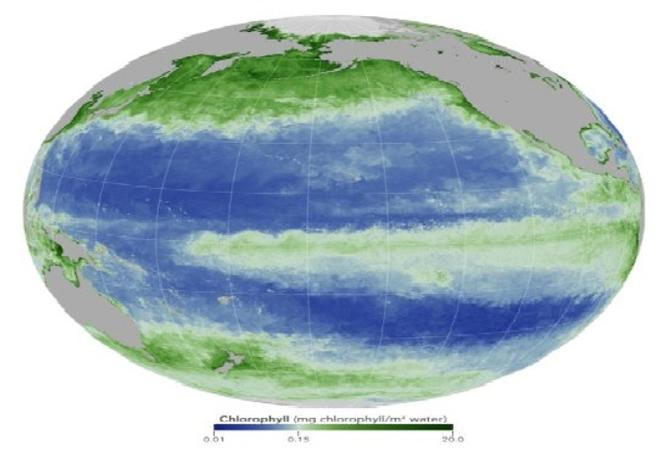El Niño disrupts the marine food web + Video
by earthobservatory.nasa.gov on 16 Nov 2015

acquired October 1 - 31, 2014 - El Niño NASA Earth Observatory
Since the spring of 2015, observations collected by the National Oceanic and Atmospheric Administration (NOAA) and NASA indicate El Niño conditions in the equatorial Pacific have been strengthening to a magnitude similar to events in 1997–98 and 1982–83, which are the two strongest events in the modern scientific record. Trade winds have weakened in the Eastern Pacific, disrupting the normal ocean circulation pattern and allowing the Western Pacific warm pool to propagate eastward.
Below the ocean’s surface, that warm pool is deepening the thermocline—the level that separates warmer surface waters from cooler deep ocean waters—in the east. The deeper pool of warm water has curtailed the usual upwelling of deep water nutrients to the surface of the Eastern Pacific. This loss of the usual nutrient supply is evident in declining concentrations of sea surface chlorophyll, the green pigment that indicates the presence of phytoplankton.
The globes above compare sea surface chlorophyll in the Pacific Ocean as observed in October 2014 and 2015. Both images are derived from data acquired by the Moderate Resolution Imaging Spectroradiometer (MODIS) on NASA’s Aqua satellite. Shades of green indicate more chlorophyll (in milligrams per cubic meter) and blooming phytoplankton. Shades of blue indicate less chlorophyll and less phytoplankton. Turn on the image comparison tool to see the subtle changes in concentrations.
Although this El Niño has not yet reached its peak, the marine food web is starting to feel the loss of its usual food supply. Historic observations from the area have shown that with less phytoplankton available, fish that feed upon plankton, as well the bigger fish that feed on them, have a greatly reduced food supply. In past El Niños of this magnitude, the decline in fish stocks has led to many marine animals—including Galapagos penguins, marine iguanas, sea lions and seals—experiencing famine and dramatic population declines.
All models compiled by the International Research Institute for Climate and Society and the NOAA Climate Prediction Center predict this El Niño will peak around December and weaken during northern hemisphere spring (March–May 2016). The last time such a strong El Niño occurred (1997–98), there were large population declines throughout the Eastern Pacific marine food web. A strong La Niña then followed in 1998–99 and had the opposite impact: stronger east-to-west trade winds increased upwelling nutrients and fertilized one of the biggest phytoplankton blooms in the satellite record. This brought a dramatic increase in fish populations.
Whether the current El Niño will mirror 1997–98, and whether it will then change to a strong La Niña, is too soon to say.
http://earthobservatory.nasa.gov/IOTD/view.php?id=86895&eocn=image&eoci=moreiotd
If you want to link to this article then please use this URL: www.sailworldcruising.com/140129

